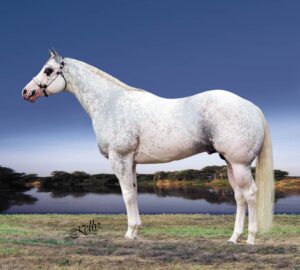With greater understanding about how color and pattern genes work and a lot of research and tests available, Paint Horse breeders have a wealth of knowledge at their fingertips—understanding the nuts and bolts behind genes like Tobiano, Frame Overo, Sabino 1, and Splash White 1, 2 and 3, have helped breeders predict and even increase the amount of color in their programs. But what about one of the equine industry’s newest discoveries: Dominant White?
If you’re not familiar with Dominant White, you’re not alone—the name isn’t very descriptive, and the genetics behind this relatively new pattern are confusing to say the least. Understanding how the W genes work might lead researchers to find other white pattern genes, and it can help you increase the color in your own breeding program.
 While 20+ Dominant White (W) genes have been discovered to date, only a select few have been recorded in Paint Horses. W5 is linked to the Puchilingui line of Thoroughbreds, which includes Paints like Artic Color and Sato. W10 was first identified in GQ Santana (right, photo by KellyGraphics LLC) and his offspring.
While 20+ Dominant White (W) genes have been discovered to date, only a select few have been recorded in Paint Horses. W5 is linked to the Puchilingui line of Thoroughbreds, which includes Paints like Artic Color and Sato. W10 was first identified in GQ Santana (right, photo by KellyGraphics LLC) and his offspring.
The October 2014 Paint Horse Journal article “Dominant What?” took readers inside the Dominant White gene to help explain this perplexing pattern and the genetics behind it. Copies of this issue may be ordered online at phj.apha.com/subscription or by calling (817) 222-6423.
Has Dominant White piqued your interest? Here’s 10 things you need to know about the W10 gene.
- Researchers have discovered 20 different mutations causing dominant white. They are currently studying W20.
- W10 began with a single individual: GQ Santana, foaled in 2000.
- Dominant white does not always produce an all-white horse.
- Dominant white is a “dominant” pattern of white spotting. If a horse inherits one copy of the Dominant White allele, he will express that phenotype, just like the Tobiano allele. Heterozygous dominant whites throw 50 percent color, on average, when bred to solid horses.
- The W10 pattern might look like the sabino pattern, but genetically, the two have different causes.
- The W10 phenotype varies widely, from four high stockings and a belly spot to an almost all-white horse with underlying dark spots.
- Breeders report virtually no “minimal” W10s. All the foals known to carry this gene were eligible for the Regular Registry; however, a few all-white foals, however, were registered as solid Paint-breds, due to APHA requirements for contrasting color.
- The University of California–Davis offers a genetic test using a hair sample to determine if a horse carries W10. The cost is $25; learn more at vgl.ucdavis.edu.
- At present time, genetic testing has not revealed any homozygous dominant whites. It’s unproven, but W10 might be lethal in the homozygous state, causing the mare to abort.
- To date, no genetic diseases have been linked to W10.
The Paint Horse Journal is your leading source for Paint Horse-specific information. Subscribe or renew to the Paint Horse Journal so you never miss great articles like this one.
##
About APHA





